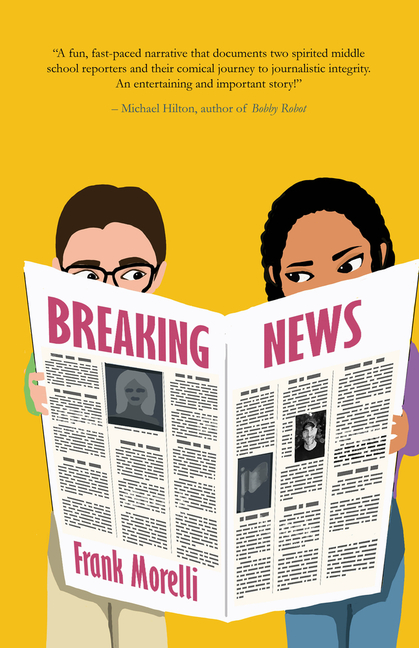From Teaching to Writing

TeachingBooks asks each author or illustrator to reflect on their journey from teaching to writing. Enjoy the following from Frank Morelli.

The year was 2016. New Year’s Eve. The Oxford Dictionary had recently announced its latest ‘Word of the Year’ entry.
Post truth.
I spilled out my glass of champagne, looked long and hard in the mirror and said, “I need to write a new novel.” End scene.
Ok. So maybe it wasn’t that dramatic in reality–but what is reality anyway? These days, with an informational avalanche raining down on us from every social media platform, streaming service, media outlet, and dark corner of the internet, holding onto even a thread of genuine, bonafide truth has become harder than ever.
But I’ve dabbled in journalism before, and I’ve written novels for children for years, and taught them in the classroom for twice as long as that, so I knew in my heart when ‘post truth’ was entered in the dictionary that it had never been more important to fortify our children with the superpower of critical thinking than it was at that moment. And the moment following it. And the moments following that.
I dove into writing a novel for middle grade readers. A mystery story with multiple narrators who slowly divulge the “facts” of the case through primary documents alone. My goal was simple: to provide students and educators with an entertaining work of fiction that would invite them into the story as valiant fact checkers building the skills necessary to spot bias at the pace of a speeding bullet and leap the tallest lies to find truth on the other side. The result is my latest middle grade novel, Breaking News, but the journey didn’t end there for me.
Because I’m a teacher and I can’t leave well enough alone. I have to tinker. I have to teach.
So, I decided to integrate more opportunities for critical thinking and media literacy into my middle grade language arts classroom. Not as one-off lesson plans or even through a single unit of study, but holistically. Administered liberally throughout the school year and sometimes in ways my students scarcely recognized as being media related. I implemented my approach a few years ago and, in that time, I’ve learned three important lessons that I hold above the rest.
Understanding the media from a behind-the-scenes view gives students a window into the decisions journalists make when choosing which story to cover, how to gather the information for that story, and how to present the story to a specific audience.

Take Time to Teach the Basics of Journalism
A 2019 study shows that students who understand the process by which information is produced into news for consumption are able to decipher facts from misinformation at a much higher clip than students who are unfamiliar with news procedure. Understanding the media from a behind-the-scenes view gives students a window into the decisions journalists make when choosing which story to cover, how to gather the information for that story, and how to present the story to a specific audience. A familiarity with news procedure could help students identify different modes of reporting, decipher between opinion-based and fact-based writing, and even understand how business decisions and advertising can affect the delivery of a given story.
I dedicate an entire unit to studying the news media in my middle school language arts classroom, where we compare the basic structures of news articles, feature articles, and editorials, and study the art of the interview en route to producing online news journals in small groups of three or four students. The results of a long-term exercise like this one reveal themselves the next time your students are asked to analyze a current news article, or find reliable research on a topic of interest, or identify and assess the contrasting arguments in a pro versus con piece.
Don’t Skip the Advertisements
From a contextual standpoint, it seems vitally important that middle school students understand the business structure of the news media, where $285 billion was spent on advertising in 2021 in the United States alone, and how those economic pressures could influence the presentation of information. But it’s also important for educators to remember that advertising itself provides a premade opportunity for students to develop high level critical thinking skills.
A simple banner ad on a website, or a billboard on the highway, or your basic thirty second spot on a local television station could yield a veritable treasure trove of analytic exercise, from the identification of intended audience, to a study on the various modes of persuasion, to an examination of the effects of the visual and spatial aspects on its viewer.
The analysis of advertising can even take on historical context as it has in my classroom when we’ve compared and contrasted World War II era posters from around the globe and written essays connecting the content, technique, and intent to the historical context of that particular nation’s audience. In each of these exercises, students are building the kinds of skills that result in digitally literate, media savvy, critical thinkers. The kinds of readers who can decipher fact from fiction at a higher clip than most and those least likely to fall victim to misinformation.
But the act of thinking critically is by no means a media creation.

A Holistic Approach to Critical Thinking
I know it’s easy to forget that critical thinking skills are not endemic to studying media alone. Let’s face it, it feels like we experience information overload almost one hundred percent of the time, so the media can take up an outsized portion of our brain space. But the act of thinking critically is by no means a media creation. It’s a skill humans develop through participation in a process, not by spectating from the sidelines.
It’s something that slowly takes shape as we read and discuss literature–in particular, stories like Breaking News and other books in the mystery genre that invite readers into the action and compel them to become the valiant and heroic fact checkers of their own tales. It’s something that grows through under-utilized exercises like creative writing prompts that set specific parameters on the perspective of the narration and force student writers to view life variables through a new lens. And it’s something that solidifies as we engage in open debate on controversial topics using arguments that are based on the merits of research and fact and truth alone.
In other words, critical thinking is not something we develop solely within the bubble of media study. It’s more of a shield we bring with us to the battle that protects us from the slings and arrows of misinformation.
I hope as teachers, as authors, and as parents, we can continue to work together to provide students with ample opportunity to smelt themselves the strongest shields in the kingdom. And then maybe we won’t ever need to look up that dreaded entry in the Oxford Dictionary.
Frank Morelli is the author of the young adult novels On the Way to Birdland (2021) and No Sad Songs (2018), a YALSA Quick Picks for Reluctant Readers nominee and winner of an American Fiction Award for best coming of age story. In his new middle grade novel, Breaking News (2022), two rival reporters try to hide their involvement in a fundraising scandal by publishing dueling articles in their middle school newspapers and the only person who can uncover the shocking truth is you, the reader. A Philadelphia native, Morelli now lives in High Point, NC where he’s finishing up his nineteenth year in the middle school classroom.
Books and Resources

TeachingBooks personalizes connections to books and authors. Enjoy the following on Frank Morelli and the books he’s created.
Listen to Frank Morelli talking with TeachingBooks about the backstory for writing Breaking News. You can click the player below or experience the recording on TeachingBooks, where you can read along as you listen, and also translate the text to another language.
- Listen to Frank Morelli talk about his name
- Watch the Book Trailer for Breaking News
- Discover Frank Morelli’s page and books on TeachingBooks
- Visit Frank Morelli on his website, Twitter, Instagram, Facebook, YouTube, and GoodReads.
Explore all of the For Teachers, By Teachers blog posts.
Special thanks to Frank Morelli and Fitzroy Books for their support of this post. All text and images are courtesy of Frank Morelli and Fitzroy Books, and may not be used without expressed written consent.



Leave a Reply